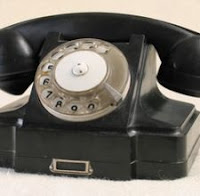Those of us with a little age on us recall the days when Ma Bell ran everything and everyone had the plain black or ivory tabletop rotary phone that weighed a ton and could cave a man's head in if used as a blunt force weapon. Dialing was accomplished by rotary pulse dialing. This remained the standard until phone company deregulation began to accelerate the adoption of newer technologies. I'm old enough to remember how exciting Touch tone dialing was when first began to be adopted by the masses. Caller ID, call waiting, call forwarding, three way calling and telco issued voicemail would all follow in quick succession. All of this was delivered on copper trunk lines-many of which had been in place for decades. The peak of standard land-line telephony had been reached. The dawn of the internet age would undo all of that in a few short years.
Initially, computers were connected to the internet by dialing up through these same P.O.T.S lines. The max speed of 56K/sec quickly proved to be too slow for customers who found themselves wishing to download music and watch streaming video. Digital Subscriber Line (DSL) allowed the customer to access a faster internet...once again through the aging P.O.T.S infrastructure. DSLwould quickly find itself in competition with other faster internet services, and the telcos themselves threatened by mobile phones supplanting landlines and a multitude of other home phone options.
The Cable television companies began running fiber-optic infrastructure into cities and towns in the mid to late nineties. This allowed cable providers to provide blazing fast cable internet, access to hundreds of digital television channels and most importantly-begin to provide home phone service. These 'triple threat' packages greatly increased the market share of cable companies because consumers could now get television video quality that rivaled mini dish satellite with fewer signal problems, reliable home telephone service, and blazing fast internet.
Cable's sudden lunge in market share forced the telcos to change their approach. AT&T began modernizing their infrastructure to digital so they could offer faster DSL and also provide television through a new service they dubbed U-Verse. The result is that many areas now have access to this service or a similar service from another large telco.
The sticking point for alarm companies has been the digital communicator device common to all alarm panels. This device was designed to pick up a standard P.O.T.S line and transmit a digital packet of information to the Alarm Central Station. The cable phone and internet phone providers such asVonage use Voice over IP (or VoIP) technology. This technology is designed to convert a human voice to a data packet and back again. It has proven unreliable in converting alarm data signals to VoIP data packets and back again. It may work 100 times in a row and fail when it really counts.
Further complicating the issue is the stage is now set for the next step-eliminating P.O.T.S lines altogether. This could happen as early as 2014. The FCC is currently examining how to sunset out of existence the remaining PSTN (Public Switched Telephone Network) and POTS lines. AT&T in particular is lobbying hard for this 2014 deadline because they have much of the infrastructure backbone in place to capitalize on this seismic shift.
 |
| Telguard's radios are an excellent option for primary or secondary alarm communication |
So now the inevitable question-"How does all this affect me?" If you are using an alarm panel that is monitored by a central station via telephone lines you will have to switch to another method of communication. Options include a GSM radio/cellular alarm communicator or an IP based internet communicator. Both of these options are available today and are reliable alternatives to P.O.T.S.
I recommend making an existing account radio primary. This typically costs $150-$200 for the cellular alarm communicator plus an additional average monthly cost of $12 for cellular data transmission. I further recommend disconnecting your land line service-chances are you seldom use it anyway. Prepare for the switch by having your security company install a cellular alarm communicator. This presents a net monthly savings that quickly covers the up-front costs because you are replacing a $30-$40 monthly expense with a $12 monthly expense. In addition, you are prepared for the upcoming sunset of P.O.T.S lines because you have a technology that will continue to work after 2014.




